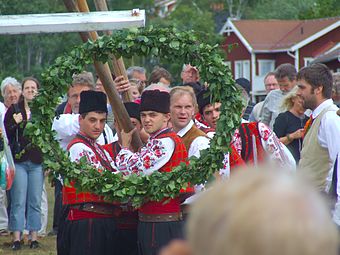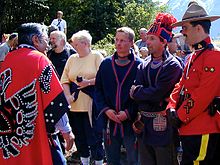folklore
Folklore ( English folk "people" and lore "tradition" or "knowledge") is the visible expression of the intangible cultural heritage of an ethnic or religious community. It encompasses long-standing traditions of the people (e.g. material culture , cults , rites , customs , customs , music , art , literature ) and is based on cross-generational tradition, which is oral , but in some cases has been fixed in writing or figuratively for some time may exist. Modern cultural manifestations, which can also be an expression of a cultural or subcultural community, are usually not counted as part of folklore, nor are high-cultural achievements, which can also be typical of the country or culture-specific, but do not have a popular character.
Scientifically, folklore is the discipline of folklore as a branch of general folklore and narrative research .
In German, the term folklore is sometimes used disparagingly for picturesque performances that ostensibly are proclaimed as original folk good, but rather commercialized, kitsch , trivial-sentimental or fake representations of alleged folk customs or the like. included (→ see: Folklorism and Factors ) .
Concept history

The forerunners of the term go back to the 18th century in the German-speaking world. Johann Gottfried von Herder common first terms such as " folk song " (English. Folksong ), " national soul " or " popular belief " and undertook 1778/79 with the publication of his collection voices of the people in songs the first attempt, traditions and cultural heritage of the common people to document and archive. It was only with the Brothers Grimm, who published the first volume of their Children's and Household Tales in 1812 , that folklore documentation reached a scientific level.
The English made-up word "folk-lore" was created by the cultural historian William John Thoms (1803-1885). It first appears as the headline of an article in the London literary weekly The Athenaeum , which Thoms published in August 1846 under the pseudonym Ambrose Merton . The word, as Thoms explained, means "folk tradition" ("the lore of the people"). He saw a need for a new English word, which so far used term "popular antiquities" (popular antiquities) , replaced by that of the Brothers Grimm (especially Jacob Grimm's German Mythology from 1835) published Volksgut to assign better.
Thoms had taken the word from the Anglo-Saxon language of the 11th century, where the term “folklǡr” is encountered. In Old English "lǡr" meant something like "knowledge, teaching". The word folk in English denotes the people, the people - with a certain social accent on the less educated classes, but in contrast to people and even more clearly to the German word "Volk" without national content.
The new name caught on very quickly and became a common term in less than a year, although Thoms never gave a more precise definition of the term. It also penetrated the Scandinavian languages and even some Romance languages within a few decades. Thoms' work stimulated the establishment of the English "Folk-Lore Society" in 1878, which he led himself. In America , the "American Folklore Society" was founded in 1888 under its President Francis James Child , who began studying English and Scottish folk ballads around 1856. On the other hand, the term was largely rejected in German-speaking folklore as a fashionable foreign word and could not become familiar. Ideological defense also played a role here, because it was feared that the word “folklore” might lose the national content of folklore. Karl Knortz , who emigrated to the United States in 1863, was an exception to this. He wrote a book entitled Folklore , which he published in Dresden in 1896 and which was published in 1846 in England, "for the first time in England and since then adopted in all civilized countries New York and Indiana at the university based lectures, sought to gain entry into the German scientific discourse. By “folklore” he understood the “quintessence of the thought work of an entire people, still unspoiled by culture, to which in this case not only the Aborigines and old Franconian people, but also all the children of the earth belong”. In America in particular, the broad definition of the term scope gained acceptance. Francis Abernethy basically defines folklore as the traditional knowledge of a culture.
content
From the word folklore it follows that it is the traditional culture of a people or a community. The concept of culture in the narrower folkloric sense is often limited to artistic and literary forms of expression and not necessarily understood in the broader anthropological sense as a general way of life in a society. Tradition is understood as being passed on from generation to generation, the people as a traditional community, which is differentiated from other communities by peculiar customs and traditions.

In German, the term is used today as a collective term for the mostly regionally bound manifestations of popular music, literature and festival culture with which folklore deals. In addition to folk song, folk dance and folk music , which describes "folklore" as an object of musicology , folklore and literary studies also include folk customs, sagas , fairy tales , fables , legends , proverbs , costumes , rhymes , rascals , folk theater , ballads , jokes , magic spells , Professional traditions or characteristic craft techniques related to folklore.
Folklore finds its material expression in local variants of handicrafts , architecture and in jewelry, clothing and typical food and drinks. In many cultures, popular piety and popular religious festivals are an inseparable part of folklore. Even profane folklore can religious or mythological contain elements. Legends and folk tales can have religious and edifying traditions or natural religious traits.
Musical folklore is the vocal and instrumental music of the people.
Delimitation and special meanings
Folklore is separated from modern cultural phenomena, which lack the historical tradition from ancient times; of the achievements of high or elite culture which lack the characteristic of being popular; likewise of replicas , reconstructions (including re-enactments ), art formations and new creations (such as “invented cultures” such as JRR Tolkien's The Lord of the Rings ) that have never been part of the real culture of a community; and other fictitious cultural contents (such as the spaghetti monster religion ), which may have artistic value, but are not counted as part of the established cultural heritage.
Starting in the USA , in the English-speaking world a narrowing of the term to musical forms has become commonplace. The focus is on the folk song, especially its contemporary manifestations such as folk music .
See also
literature
- Hermann Bausinger : folklore, folklore. In: Encyclopedia of Fairy Tales , Volume 4 (1984), Sp. 1397-1403.
- Fritz Willy Schulze: Folklore: to derive the prehistory of a scientific name. Niemeyer, Halle 1949.
- Walter Hansen: The great book of folk poetry rhymes, riddles, sayings, songs and ballads from ten centuries , illustrated by Gabi Kohwagner, Weltbild Verlag GmbH, Augsburg 2000, ISBN 3-8289-6760-4 .
- Jana C. Schlinkert: Lively folkloric expressions of traditional communities - Legal treatment options on an international level . BWV – Berliner Wissenschaftsverlag, Berlin 2007. ISBN 978-3-8305-1278-3 . Limited preview on books.google.de .
Web links
- Folklore Europaea (multimedia database on European customs)
- CIOFF®: International Council of Organizations of Folklore Festivals and Folk Arts
Individual evidence
- ^ Hermann Bausinger : Folklore and sunken cultural assets. In: Deutsches Jahrbuch für Volkskunde 12 (1966), Akademie-Verlag, Berlin 1967, pp. 15-25 ( online ), here: p. 25.
- ^ Alan Dundes: Interpreting Folklore. Indiana University Press, Bloomington 1980, p. 1 ( limited preview in Google Book search).
- ↑ The Athenaeum of August 22, 1846, p. 862 f .; According to R. Troy Boyer: The Forsaken Founder, William John Thoms. From Antiquities To Folklore. Terre Haute ( Indiana ) 1997, p. 55.
- ^ A b c d Hermann Bausinger: Folklore and sunken cultural assets. In: Deutsches Jahrbuch für Volkskunde 12 (1966), p. 15 f.
- ^ A b R. Troy Boyer: The Forsaken Founder, William John Thoms. From Antiquities To Folklore. In: Robert L. Baker (ed.): The Folklore Historian Volume 14 (1997), Indiana State University , Terre Haute (Indiana) 1997, ISSN 1041-8644 , pp. 55-61, here: p. 55 ( restricted preview in Google Book Search).
- ↑ Ronald L. Baker: Editor's Introduction: Thoms, Child and Boas. - In: ders. (Ed.): The Folklore Historian Volume 14 (1997), Indiana State University, Terre Haute (Indiana) 1997, pp. 5–6, here: p. 5.
- ↑ Ursula Hermann (Ed.): Knaur's dictionary of origin. Etymology and history of 10,000 interesting words. Lexicographical Institute, Droemer Knaur , Munich 1982, p. 165.
- ^ Karl Knortz: Folklore. With the appendix: American nursery rhymes. Verlag und Druckerei Glöß, Dresden 1896 (reprint: Dogma / Europäische Hochschulverlag, Bremen 2012, ISBN 978-3-95454-874-3 ), p. 1 ( limited preview in the Google book search).
- ^ Francis E. Abernethy: Classroom Definition of Folklore. In: ders. (Ed.): Between the Cracks of History. Essays on Teaching and Illustrating Folklore. University of North Texas Press, Denton 1997, p. 4; proven and cited by: Tom Crum: Is It Folklore or History? The Answer May Be Important. In: Kenneth L. Untiedt (Ed.): Folklore: In All of Us, In All We Do (PDF; 3.1 MB). Publications of the Texas Folklore Society LXIII, University of North Texas Press, Denton 2006, pp. 3-11, here: pp. 4 u. Note 6.
- ↑ Jana C. Schlinkert: Lively folk expressions of traditional communities. Legal treatment options on an international level (= writings on transnational business law ). BWV – Berliner Wissenschaftsverlag, Berlin 2007, ISBN 978-3-8305-1278-3 , p. 30th ff . ( limited preview in Google Book search).
- ↑ Jana C. Schlinkert: Lively folk expressions of traditional communities. Berlin 2007, p. 35 f.
- ↑ Jana C. Schlinkert: Lively folk expressions of traditional communities. Berlin 2007, p. 37 f.
- ↑ Jana C. Schlinkert: Lively folk expressions of traditional communities. Berlin 2007, p. 33 f.
- ^ A b Peter Wicke , Wieland Ziegenrücker: Sachlexikon Popularmusik. 1st edition, paperback edition, Goldmann, Munich 1987, p. 134 f.
- ↑ The Duden. Volume 5: Duden foreign currency book. 5., rework. u. exp. Ed., Dudenverlag, Leipzig / Vienna / Zurich 1990, p. 259.
- ↑ Jana C. Schlinkert: Lively folk expressions of traditional communities. Berlin 2007, p. 40.



